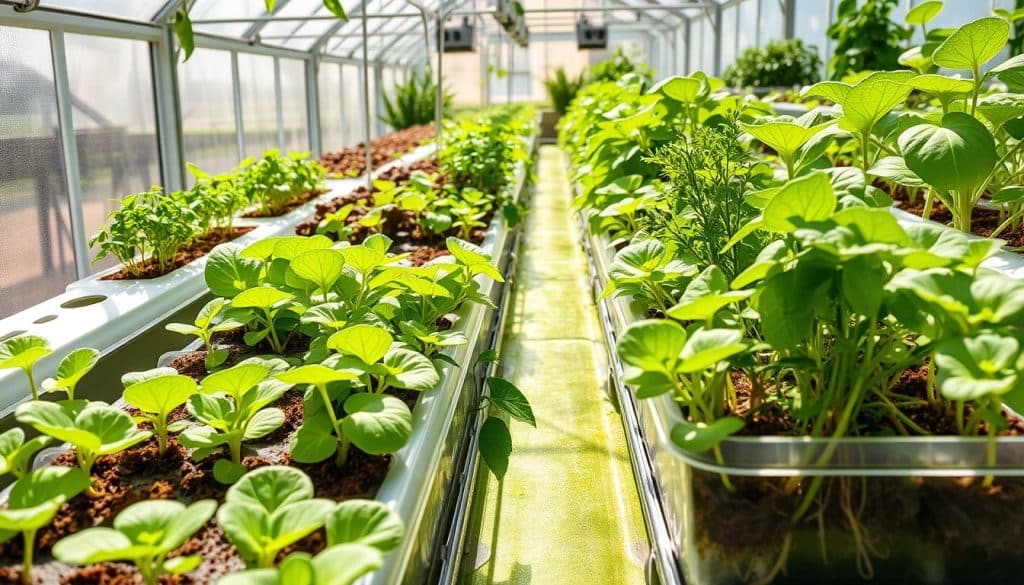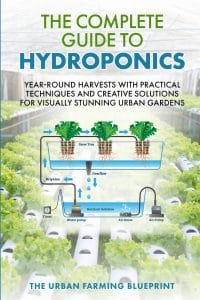If you’re new to gardening or experienced, hydroponic plant propagation has big benefits. You’ll learn how to make your indoor garden flourish. We’ll explore hydroponic seed germination step by step.
Key Takeaways
- Hydroponic seed starting is cleaner and prevents soil-related issues.
- Seeds sprout within three to five days when grown hydroponically.
- Controlled environments enhance growth rates and yields.
- Proper seed selection is key for hydroponic gardening success.
- Regular monitoring of pH and nutrient levels is essential.
The Basics of Hydroponic Seed Germination
Hydroponic seed germination starts seeds in water, not soil. This method controls the environment better. It leads to faster and more even germination than traditional ways.
What is Hydroponic Seed Germination?
It’s a way to start seeds without soil. Seeds grow in water with nutrients. Important factors like water pH, light, and nutrient quality affect germination.
Following tips for seed germination in hydroponics can help. It can make seedlings healthier and more successful.
Advantages of Hydroponic Seed Starting
Hydroponics has many benefits. Seeds germinate faster, leading to quicker crops. It also keeps pests and diseases away, making gardening safer.
Nutrients are always available, helping seedlings grow strong. Studies show crops grow more in hydroponics. This shows how efficient and beneficial hydroponics can be.

| Factor | Recommended Levels |
|---|---|
| Light Levels | 14 hours of sunlight per day, at least 12 mol/m²/day |
| pH Range | 5.8 – 6.2 |
| EC for Lettuce | 0.8 – 1.4 mS/cm |
| Nutrient Solution Change | Every 3 – 4 weeks |
How to Grow Seeds for Hydroponics
Growing seeds for hydroponics needs careful planning and the right tools. Picking the right seeds is key. Knowing the essential tools for hydroponics is also important for great results. This section will help you choose the best seeds and the materials you need for starting seeds.
Choosing the Right Seeds for Your Hydroponic System
Choosing the right seeds is vital for healthy plant growth. High-quality seeds from trusted sources are a must. Some seeds work better in hydroponic systems than others.
For example, feminized seeds often give better results. Make sure the seeds fit your hydroponic system’s needs. This includes light and nutrients. Different plants need different things:
- Lettuce likes cooler climates and moderate nutrients.
- Tomatoes need more nutrients and light.
- Cucumbers need special care for nutrients and moisture.

Essential Tools and Materials for Hydroponic Seed Starting
Having the right tools makes starting seeds easier. Some key tools for hydroponics are:
- Hydroponic cloners – great for fast plant growth.
- Nutrient solutions – plants need these minerals.
- Growing mediums – like rock wool or coco coir help roots grow.
- Light sources – plants need at least 14 hours of light daily.
Using these tools well is key to growing healthy plants. Watch the nutrient solution’s EC levels. Different plants need different levels for growth. Keep the pH right, check moisture, and make sure there’s enough air. With these steps and tools, you can start a thriving hydroponic garden.
Preparing Your Hydroponic System
Setting up a hydroponic system is key for growing healthy plants. You need the right parts to make sure seeds and seedlings grow well.
Setting Up a Hydroponic Cloner
A hydroponic cloner is important for seed growth. It has net pots in a nutrient solution. This setup helps seedlings grow strong.
Make sure the nutrient solution has enough oxygen. Oxygen is important for healthy roots.
The Role of Air Pumps and Air Stones
Air pumps help a lot in hydroponics. They make sure the nutrient solution gets enough air. This helps seeds grow better.
Air stones break the air into tiny bubbles. This increases oxygen in the solution. It also stops root diseases and helps roots grow strong.
Keep the air moving to keep the solution oxygen-rich. Check the pH levels often. Keep them between 5.8 and 6.2. Adjust the nutrient solution as needed for the best growth.
Sowing Seeds in Hydroponic Systems
Sowing seeds in hydroponic systems needs careful attention. Choosing the right tools and mediums is key. Starter plugs and net pots help seeds grow well.
These tools keep seeds moist and support their growth. They help seeds get the right amount of moisture and support as they grow.
Using Starter Plugs and Net Pots
Starter plugs, like Rockwool, hold moisture well. They help seeds grow in the beginning. Net pots should fit the growing roots well.
This setup makes it easier to manage light and moisture. It helps seeds grow better.
The Importance of Moisture for Seed Germination
Keeping the right moisture is key for seed germination. Seeds need consistent watering, checked twice a day. This avoids too much dryness or water.
A moist environment helps seeds sprout and grow. Keeping humidity at 60-70% helps seeds germinate better.
Checking moisture levels helps seeds grow. Most seeds germinate in 7-14 days. So, managing time and moisture is very important.
Understanding Nutrient Solutions
Managing nutrient solutions is key to hydroponic seed growth success. Choosing the right nutrient solutions for seedlings is vital. These solutions give essential nutrients for healthy growth.
They contain nitrogen, phosphorus, and potassium. Also, important secondary nutrients like calcium, magnesium, and sulfur.
Choosing the Right Nutrient Solutions for Seedlings
Think about what seedlings need when picking nutrient solutions. A starting strength of about 300 ppm is good. Adjustments and monitoring are needed as plants grow.
Adding micronutrients like iron, manganese, and zinc is also important. They prevent growth problems and keep plants healthy.
Monitoring pH Levels and Electrical Conductivity
Keeping pH levels right is important for nutrient absorption. The best pH range is 5.8 to 6.2. This helps plants take in nutrients well.
Checking pH and electrical conductivity (EC) regularly is key. EC shows the nutrient level in solutions. It helps spot problems that can harm plants. Adjusting these levels can greatly help seedlings grow well.
| Nutrient Type | Function | Sources |
|---|---|---|
| Macronutrients | Essential for plant growth and development | Nitrogen, Phosphorus, Potassium |
| Secondary Nutrients | Support overall plant development | Calcium, Magnesium, Sulfur |
| Micronutrients | Prevent deficiencies that impair growth | Iron, Manganese, Zinc, Copper, Boron, Molybdenum, Chlorine |
Best Practices for Seedling Development in Hydroponics
Creating the perfect conditions for seedlings is key in hydroponics. Managing light, temperature, and air well boosts growth. This ensures a smooth move from germination to growth.
By following the best practices, you can grow strong and healthy plants. This sets the stage for a thriving garden.
Providing Optimal Light and Temperature Conditions
Lighting is critical for seedling growth. An 18-hour light cycle, with 6 hours of darkness, helps them grow well. Most veggies need at least 12 mol of light per square meter daily.
For germination, keep temperatures between 68°F and 86°F. Seedlings do best at 75°F (24°C) during the day. A 10°F (12°C) drop at night helps growth and root strength.
Maintaining Air Circulation and Oxygen Levels
Good air circulation is vital in hydroponics. It prevents diseases like mold and mildew. These diseases can slow down plant growth.
Air movement also makes seedlings’ stems stronger. This helps them support more growth later. Fans or ventilation systems help keep air moving around plants.
By keeping these conditions right, you create a healthy environment for seedlings. This is the start of a successful hydroponic garden.
Hydroponic Seedling Care
Good care in the seedling stage is key for hydroponic plant growth. Knowing how to water and when to add nutrients is important. It helps prevent root rot and supports healthy growth.
When seedlings grow, moving them to bigger hydroponic systems is important. This step helps them grow strong.
Watering Techniques and Nutrient Timing
Keeping the right amount of moisture is vital. Too much water can harm roots, while too little causes stress. Here are some good watering methods:
- Drip irrigation: Gives water and nutrients right to the roots.
- Flood and drain systems: Mimics natural water cycles by soaking and draining.
- Capillary mats: Keeps moisture even across many seedlings.
It’s also important to know when to add nutrients. Nutrients should be given at the right times, like when plants are growing fast. For lettuce, an EC level of 0.8–1.4 mS/cm is best. This ensures plants get enough nutrients without getting too much.
Checking pH levels regularly is also key. Aim for a pH between 5.8 and 6.2. This helps nutrients work better for the plants.
Transitioning Seedlings to Advanced Hydroponic Systems
As seedlings grow, they need to move to bigger hydroponic systems. This move, called seedling transition, helps them grow faster. They go into systems like Deep Water Culture or Nutrient Film Technique.
Before moving, seedlings need to get used to their new home. Adjusting light, temperature, and nutrients helps them adjust. Keep daytime temperatures around 75°F (24°C) and nighttime temperatures between 60–65°F (16–18°C). Following these tips helps seedlings thrive in their new systems.
Conclusion
Starting a hydroponic garden is both new and efficient. Learning how to grow seeds for hydroponics can make gardening better. This guide has given you the key skills for growing seeds and seedlings well.
Soaking seeds in water for 6 to 36 hours can help them grow better. This is true for peas, cilantro, fennel, spinach, sunflower, and Swiss chard. Getting seeds from trusted U.S. companies is also key for a good garden.
When using hydroponic systems, keep an eye on pH, electrical conductivity, and moisture. These things help roots grow and keep plants healthy. With careful attention and following best practices, you’ll get good at hydroponics. You’ll also enjoy a healthy and thriving garden.
FAQ
What is hydroponic seed germination?
Hydroponic seed germination is starting seeds without soil. It uses a nutrient-rich water solution in a controlled space. This method makes seeds germinate faster and more evenly than soil methods.
What are the advantages of starting seeds in hydroponics?
Starting seeds in hydroponics has many benefits. It gives better control over the environment. It also reduces pests and diseases. Seeds get nutrients right away, helping them grow efficiently.
How do I choose the right seeds for hydroponics?
Choosing the right seeds is key. Look for high-quality seeds from trusted sources. Beginners should pick seeds made for hydroponics, like feminized seeds, for better yields.
What tools and materials do I need for hydroponic seed starting?
You’ll need a few things to start seeds. Hydroponic cloners, nutrient solutions, and growing mediums like rock wool or coco coir are essential. These help ensure a successful start.
How do I set up a hydroponic cloner?
Setting up a cloner is simple. Place cuttings in net pots in a nutrient solution. Don’t forget air pumps and air stones to keep oxygen levels up and prevent disease.
What is the importance of moisture in seed germination?
Moisture is critical for seed germination. It activates seeds and helps them grow. Use starter plugs to keep moisture in during germination.
How do I choose the right nutrient solutions for seedlings?
For seedlings, choose nutrient solutions with a starting strength of about 300 ppm. Keep the pH between 5.8 and 6.2. This ensures they get the nutrients they need for healthy growth.
What are optimal light and temperature conditions for hydroponic seedlings?
Young plants need 14 hours of light daily. They thrive in daytime temperatures around 75°F (24°C). Cooler nights help with stem development and overall health.
How should I care for my hydroponic seedlings?
Proper watering and nutrient timing are key for seedling care. Once they have strong roots, move them to more advanced hydroponic systems. This will help them grow even more.


